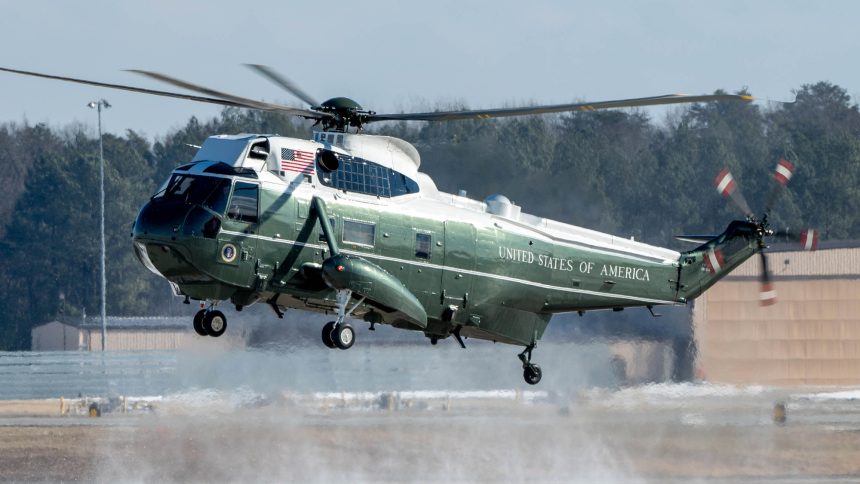Joint Base Andrews and the VH-3D Sea King: behind-the-scenes of American history.
As everybody knows by now, the inauguration of Donald Trump as the 47th president of the United States took place in Washington, DC, on Monday Jan. 20, 2025.
While presidential inaugurations are always remembered for the grand swearing-in ceremony, the inaugural address or the parade that follows (if any), there’s a location that, behind-the-scenes, always plays a crucial role in these moments of American history: Joint Base Andrews. Known as “America’s Airfield,” this base has been a cornerstone of presidential transitions for decades and a quiet witness to the continuity of American democracy.
An interesting article just published by the 316th Wing, the host wing for Joint Base Andrews, highlights the base’s connection to presidential inaugurations, a legacy that dates back to WWII.
Since then, the base, located in Prince George’s County, Maryland, southeast of DC, has served as the gateway for president-elects arriving in D.C., as well as the sendoff spot for outgoing leaders. From one commander in chief to the next, the torch is passed, and Andrews stands ready to serve. For this reason, Andrews can be considered as the place where the baton is quietly passed between administrations, away from the spotlight of TV cameras and fanfare.
For instance, in 2017, the day before Donald Trump took the office for the first time, he touched down at JB Andrews aboard a U.S. Air Force C-32, belonging to the 89th Airlift Wing, the unit, based there, that provides global Special Air Mission airlift, logistics, aerial port and communications for the president, vice president, cabinet members, combatant commanders and other senior military and elected leaders as tasked by the White House, Air Force chief of staff and AMC.
The U.S. Air Force Band and Joint Ceremonial Honor Guard practiced often at Andrews in preparation for presidential inaugurations before both units moved to Joint Base Anacostia-Bolling, D.C., in June 2020. But the connection between Andrews and the presidency stayed as strong as ever, and the base continues to serve as the launchpad for so many iconic moments in presidential history.
Dealing with sendoffs, Andrews has been the final stop for several presidents as they closed the chapter on their time in the Oval Office. Bill Clinton, George H.W. Bush, Ronald Reagan, and Jimmy Carter, all boarded planes at Andrews, waving goodbye to Washington as their term officially ended.
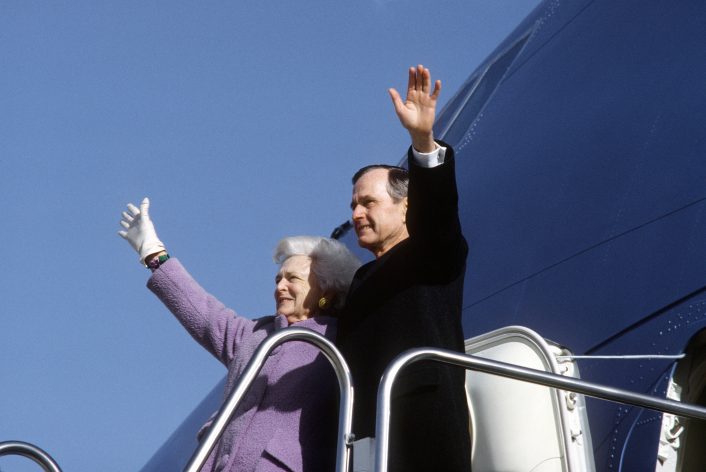
In 2021, nearly 25,000 National Guard Airmen and Soldiers provided security, communications and logistical support for President Joe Biden’s inauguration, and many of them were flown into Andrews.
But the traditions are still alive and well to date. After President Donald Trump’s second inauguration Biden and his wife, Jill, made their way to Andrews aboard a VH-3D Sea King helicopter, using callsign Nighthawk 46.
Former President @JoeBiden leaving Capitol Hill in the Sikorsky VH-3D, no longer designated as #MarineOne pic.twitter.com/OrIOvJebCu
— Patrick Oyulu (@OyuluPatrick) January 20, 2025
At the base, Biden addressed a crowd of more than 800 people, delivering his final remarks as president. Then, in a symbolic gesture that many presidents before him had taken part in, he boarded a VC-25A aircraft, designated SAM (Special Air Mission) 46, and flew off.
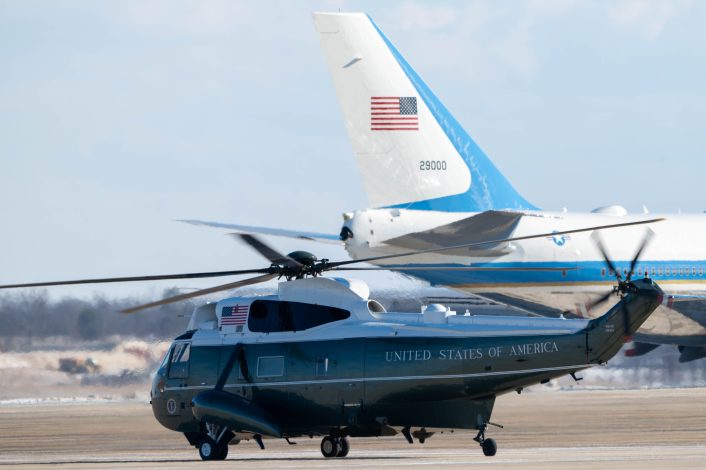
VH-3D Sea King
While the U.S. Air Force emphasized the importance of Joint Base Andrews in its release, it was the venerable VH-3D that stole the spotlight during Trump’s inauguration, with many social media users commenting on the long and storied career of the iconic helicopter during the live stream.
47 years of service for the VH-3D, and the earlier VH-3A flew POTUS starting in ‘61. Total Sea King presidential airlift service has been 64 years.
— Tyler Rogoway (@Aviation_Intel) January 21, 2025
Love seeing the iconic VH-3D today. With a design and operational history dating back to 1959, first as HSS-2, then SH-3A it was modified to VH configuration for presidential transport. Beautiful lines, including the unique boat hull. 💕🫡
Photos: F. Bench/Reuters & Sikorsky pic.twitter.com/yZHt09Adsu
— jackdoodlysquat (@jackdoodlysquat) January 20, 2025
The Sea King will be gradually replaced by the Sikorsky’s VH-92A Patriot helicopter, based on the Sikorsky S-92. As we reported in detail last year, President Biden boarded the VH-92A (serial number 169186) on the tarmac at Chicago O’Hare International Airport on Aug. 19, 2024, after stepping off Air Force One, before flying to Soldier Field where he then made a short motorcade journey to the Democratic National Convention at the United Center.
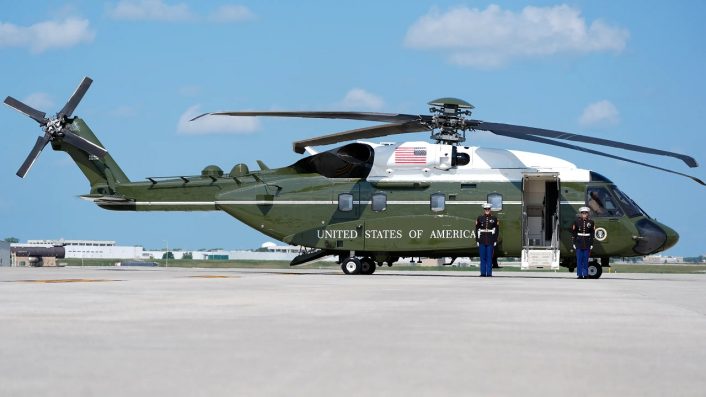
The new helicopter has had a long and somewhat troubled entry to service with Marine Helicopter Squadron One, commonly known as HMX-1. The long awaited replacement for the venerable Sikorsky VH-3D Sea Kings and VH-60N White Hawks first flew in 2017 and were first seen on trial flights at the White House in 2018.
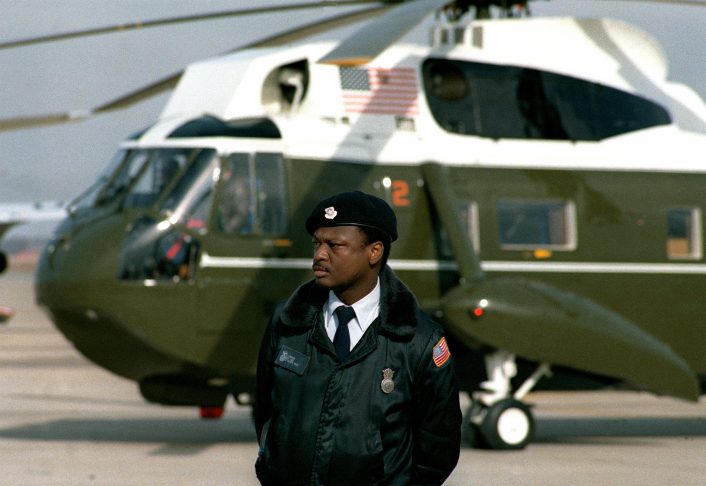
Here’s what we wrote about the VH-3D and its replacement when the first image of the VH-92A was released:
Aug. 14 saw the U.S. Marine Corps take delivery of their 23rd and final VH-92A from Sikorsky. 21 of these aircraft will serve in the operational fleet, while two will be designated as test airframes. They will replace the current operational fleet of 10 VH-3D Sea Kings and 6 VH-60N White Hawks. Until 2021, a one-of-a-kind NVH-3A Sea King also supported the fleet as a test airframe, painted in the all-over green used by HMX-1 support helicopters rather than the famous green and white seen on the airframes used as Marine One. It is unclear whether the VH-92As designated as test airframes will be differentiated in the same way.
The long development and test cycle of the VH-92 has meant the service life of HMX-1’s mainstay VH-3D Sea Kings has now stretched across five decades, with the first D model airframe entering service in 1978. The airframes themselves, having been converted from regular Sea Kings, are several years older. They replaced earlier model VH-3A Sea Kings and VH-34 Choctaws, dating from 1962 and 1957 respectively.
VH-60N White Hawks, based on the ubiquitous Sikorsky H-60 design, entered service in 1988. These helicopters are smaller than the Sea Kings, though their folding main rotor blades make them more easy to transport by air. The VH-3Ds must have their rotor blades removed for transport on board C-17 Globemaster III cargo aircraft, and the C-17 must have a minimal fuel load during the onload/offload process to ensure maximum clearance for the helicopter on the aircraft’s rear ramp.
Original plans in the 2000s were to see the legacy types replaced by the VH-71 Kestrel, a development of the AW101 Merlin helicopter backed by Lockheed Martin, which had initially beaten Sikorsky’s S-92 in the VXX Presidential Helicopter Replacement Program. Rising costs during the global financial crisis saw the Kestrel canceled in 2009. Nine airframes had already been completed, which were subsequently sold to Canada to support their existing Merlin fleet.
In the restarted VXX program that began in 2012, Sikorsky were the only manufacturer to submit a bid, leading to the S-92 being crowned as the winner in 2014. A year later, Lockheed Martin, who were part of the VH-71 Kestrel program, acquired Sikorsky for $9 billion.
It is not currently clear how long the transition process from the VH-3D and VH-60N legacy platforms to the VH-92A will take, but the older airframes will likely soldier on for a little while longer while the Patriot settles into service.

